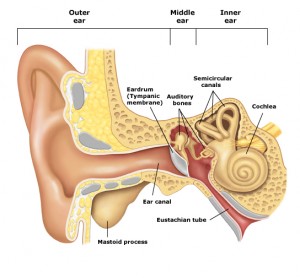Ear Infection
Profession: Consultant Paediatrician, MD (UKM), MRCPCH (UK)
Columbia Asia Hospital Cheras
Common Health Issues for Your Child: Ear Infection
Our ears are divided into the “outer ear”, “middle ear” and “inner ear”. These parts all work together so that sound can be processed and heard. The inner ears also function to keep our body balanced. Infection can occur in any part of the ears.
What is Otitis Externa?
A healthy outer ear has a self-cleaning function. Ear wax is a protective agent produced by the outer ear canal. Otitis externa is usually caused by bacterial or fungal infections. The common causes of infection in the outer ear (otitis externa) are trauma from cleaning with cotton-buds, fingernails, or foreign bodies including insects. Water exposure or trapped water in the ear may also cause infection, for example swimming in polluted water.
What are the Symptoms of Otitis Externa?
The symptoms include itching, sensation of fullness in the ear, pain and ear discharge. The outer ear may become red or swollen, and lymph nodes around the ear can be enlarged and painful. Hearing may be temporarily affected as well.
How is Otitis Externa Treated?
The doctor will remove foreign bodies, clean up the ear canal and prescribe antibiotic eardrops to fight the infection. Ear pain can be managed with pain killers.
What is Otitis Media?
Infection and inflammation of the middle ear area is known as otitis media. Middle ear infection may be present with acute otitis media, otitis media with effusion and chronic suppurative otitis media.
What is Acute Otitis Media?
Acute otitis media is middle ear infection with collection of fluid (or pus) commonly experienced by young children. Most cases are not serious but can be painful and distressing. The eardrum will appear red. A small child may have fever and have trouble sleeping. When the pressure from the fluid collected in the middle ear builds up, the eardrum can rupture causing fluid discharge which, in turn, usually relieves the pain.
What Causes Acute Otitis Media?
One main cause of acute otitis media in children is the shorter and narrower Eustachian tube, which connects the middle ear to the nasopharynx (the upper part of throat that lies behind the nose). It becomes blocked easily, e.g., as during a common cold, fluid is trapped causing infection to set in from germs found in the nose and throat. These germs can be viruses, but are more commonly bacteria like Streptococcus and Haemophilus. Other risk factors that contribute to otitis media include exposure to cigarette smoke, allergies and crowded environment such as daycare centers.
How is Otitis Media Being Diagnosed?
A child with otitis media will experience pain in the ear, as well as fever, cough, runny nose and sore throat if there is associated upper respiratory tract infection. Some may experience discharge from ear. The doctor will examine the ear and eardrum with an instrument called an otoscope. He or she may also do a tympanometry, which uses an instrument to measure changes in ear pressure or check if the eardrum has ruptured.
What is the Treatment for Acute Otitis Media?
Most cases of otitis media will resolve on their own without treatment, so doctors may not prescribe any medication besides some pain and fever relief. The child, however, must return for a follow up. Sometimes, the doctor may prescribe antibiotic eardrops or oral antibiotics, depending on the child’s condition and progress, or intravenous antibiotic if the child is ill.
What are the Consequences of Otitis Media?
If otitis media is not followed up or treated properly, the child may get complications from the infection, such as infection of the mastoid (bone behind the ear), brain infection (meningitis, brain abscess), and hearing loss. A ruptured eardrum will usually heal on its own. Some children get chronic, recurrent ear infections. This may result in hearing loss and lead to speech and language delay.
What is Otitis Media With Effusion?
Otitis media with effusion (glue ear) occurs when fluid in the middle ear remains trapped after the infection is gone. This may contribute to another bout of acute infection. If the infection is recurrent, the doctor may have to put in a drainage tube (tympanostomy tube) to temporarily take over the function of the Eustachian tube to aerate the middle ear, thus equalising the pressure between the middle and outer ear. Otitis media with effusion is the most common cause of hearing impairment in children, which may cause speech and language delay. So; it is important to adhere to treatment and follow up by doctor.
What is Chronic Suppurative Otitis Media?
Chronic suppurative otitis media is chronic inflammation of the middle ear with persistent drainage from perforated eardrums, lasting more than six weeks. Patients with facial abnormality such as cleft palate, cleft lip and Down syndrome, are at risk. These patients will have draining ear for some duration and have a history of recurrent otitis media, with hearing loss in the affected ear. They will need CT or MRI scans as well as hearing tests. Treatment includes antibiotics and regular cleaning of the ear. Some patients may need more extensive ear and mastoid surgery.
How to Minimise the Risk of Getting Otitis Media?
Prevention is always better than cure. Here are some practices that can minimise the risk of otitis media in children:
- Breastfeeding for at least six months, and continuing until the child reaches two years or older to help to build immunity.
- Avoid exposure to cigarette smoke.
- Practise good hygiene to minimise and prevent transmission of infections.
- Keep your child away from others who are sick.
- Keep the immunisation up-to-date, especially Haemophiles influenzae type b (Hib) vaccine which prevents Hib disease, and Pneumococcal vaccine which prevents pneumococcal disease. These vaccines will safeguard your child form bacteria that commonly cause otitis media.









